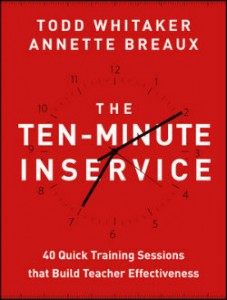Quick Inservice that Works
The Ten-Minute Inservice: 40 Quick Training Sessions that Build Teacher Effectiveness
By Todd Whitaker and Annette Breaux
(Jossey-Bass, 2013 – Learn more)
The Ten-Minute Inservice: 40 Quick Training Sessions that Build Teacher Effectiveness by Todd Whitaker and Annette Breaux is both succinct and informative. While geared for administrators, the book can also benefit teachers a lot.
Each inservice is divided into three parts: the purpose, the inservice, and the implementation, and none of them span more than five pages, so the book is convenient reading for busy administrators (or teacher leaders). The inservices are grouped into five categories which can easily be used in any order: Classroom Management, Teaching Practices, Improving School Climate, Learning from Others, and What Makes a Great Teacher.

In the implementation phase of each inservice the authors further describe how to make sure that the techniques are being implemented, while building a sense of community among the faculty.
The authors point out in the introduction that while “the ultimate goal is to have nothing but great teachers in your school,” this will not happen overnight, and in the meantime it is essential to help each teacher become more effective than they currently are.
Something to challenge everyone
Among these 40 inservices there is definitely at least one that will challenge even the most accomplished teachers.(You can browse the Table of Contents in this PDF file.)
An inservice that I intend to put into place when we go back to school is the “Teacher Report Card.” The idea is that when students are given a report card or progress report by their teachers, they should be able to provide one to their teachers. Whitaker and Breaux provide a sample teacher report card (one of the many downloadables in the book) which provides a number of open-ended questions aimed at gaining valuable honest student feedback. The authors describe how to present this to teachers, and how teachers should present it to their students to get the best results. The completed feedback forms are only viewed by the teacher and no student names are included, so they are non-threatening to all concerned.
I would highly recommend this book for any administrator or teacher. While some of the inservices are much more effective if they are used school-wide, many can be used by individual teachers or small groups of teachers in teacher learning communities.
Laura Von Staden has a Ph.D. in Molecular Immunology and a Master’s in Special Education and teaches in a Tampa, Florida middle school. She serves on numerous committees both at her school and within her district and works closely with the local university where she serves as a master mentor. Dr. Von Staden also serves as a facilitator for an online teacher learning community sponsored by her local teacher organization.




































